Introduction
Static code analysis (SCA) tools have become indispensable in the world of software development, offering a systematic approach to enhancing code quality, reliability, and security. These tools play a crucial role in preventing potential errors and vulnerabilities by providing an automated code review process, without the need to execute the code. In industries where failure can result in significant costs, such as banking, the adoption of SCA is vital for ensuring performance, compliance, and security.
M&T Bank, a renowned banking institution, embraced SCA tools to establish Clean Code standards, reducing maintenance time and costs while improving efficiency, reliability, and security. The use of SCA tools goes beyond just finding errors; it contributes to a culture of quality and excellence within development teams and organizations. By integrating SCA tools into the workflow, developers can proactively detect issues at the earliest stage of development, leading to resilient and trustworthy software systems.
With the increasing complexity of software development, the right SCA solution must offer comprehensive vulnerability coverage and support a wide range of languages and frameworks. Tools like JetBrains' dotInsights and Google's approach to managing software defects highlight the significance of insights and safe coding practices in improving the quality of code. In summary, SCA tools are essential for achieving maximum efficiency and productivity in software development, ensuring that the final product is reliable, secure, and of high quality.
Benefits of Using Static Code Analyzer Tools
Static code analysis (SCA) plays a crucial part in improving the standard of software development by ensuring that the programming is dependable, secure, and easy to maintain. These tools provide a systematic method to examine code for potential errors and vulnerabilities without executing it, effectively serving as an automated code review process. The adoption of SCA is becoming increasingly vital in industries where the cost of failure is high, such as banking, where protection and compliance are paramount.
M&T Bank, a longstanding institution with a rich history in community-focused banking, faced the challenge of maintaining high-quality standards for their technological applications to ensure performance and compliance in a rapidly digitizing industry. By adopting SCA technologies, they aimed to implement Clean Code standards throughout the organization, reducing the time and costs required for maintenance while enhancing efficiency, dependability, and safety.
In the broader perspective, the quality of a system is determined by its resilience and trustworthiness, which can be assessed at different levels such as unit, integration, and system levels. SCA tools aid in this quality evaluation by offering insights into possible problems at the initial phase of development, thereby averting flaws that could result in breaches or unstable applications.
Google's approach to managing defects emphasizes the importance of a developer ecosystem that supports safe coding practices and reduces the rate of common issues. By focusing on preventing bugs through safe coding, organizations can achieve a more dependable codebase. As expressed by Google's security engineering team, a well-designed piece of software is one that can adapt and change, embodying the principle that knowledge within a system should be unambiguous and authoritative.
In the dynamic landscape of software development, where applications depend on a complex mix of libraries and custom programming, the right SCA solution must provide comprehensive vulnerability coverage and support a broad spectrum of languages and frameworks. JetBrains' dotInsights newsletter highlighted the significance of attributes like CallerMemberName, CallerFilePath, and CallerLineNumber in providing developers with critical information for debugging and maintaining code.
To sum up, incorporating SCA solutions into the development process is not only about identifying errors, but also about fostering a culture of quality within the team and the company as a whole. As systems grow in complexity, the meticulous approach of SCA becomes indispensable in ensuring that the final product is resilient and trustworthy.
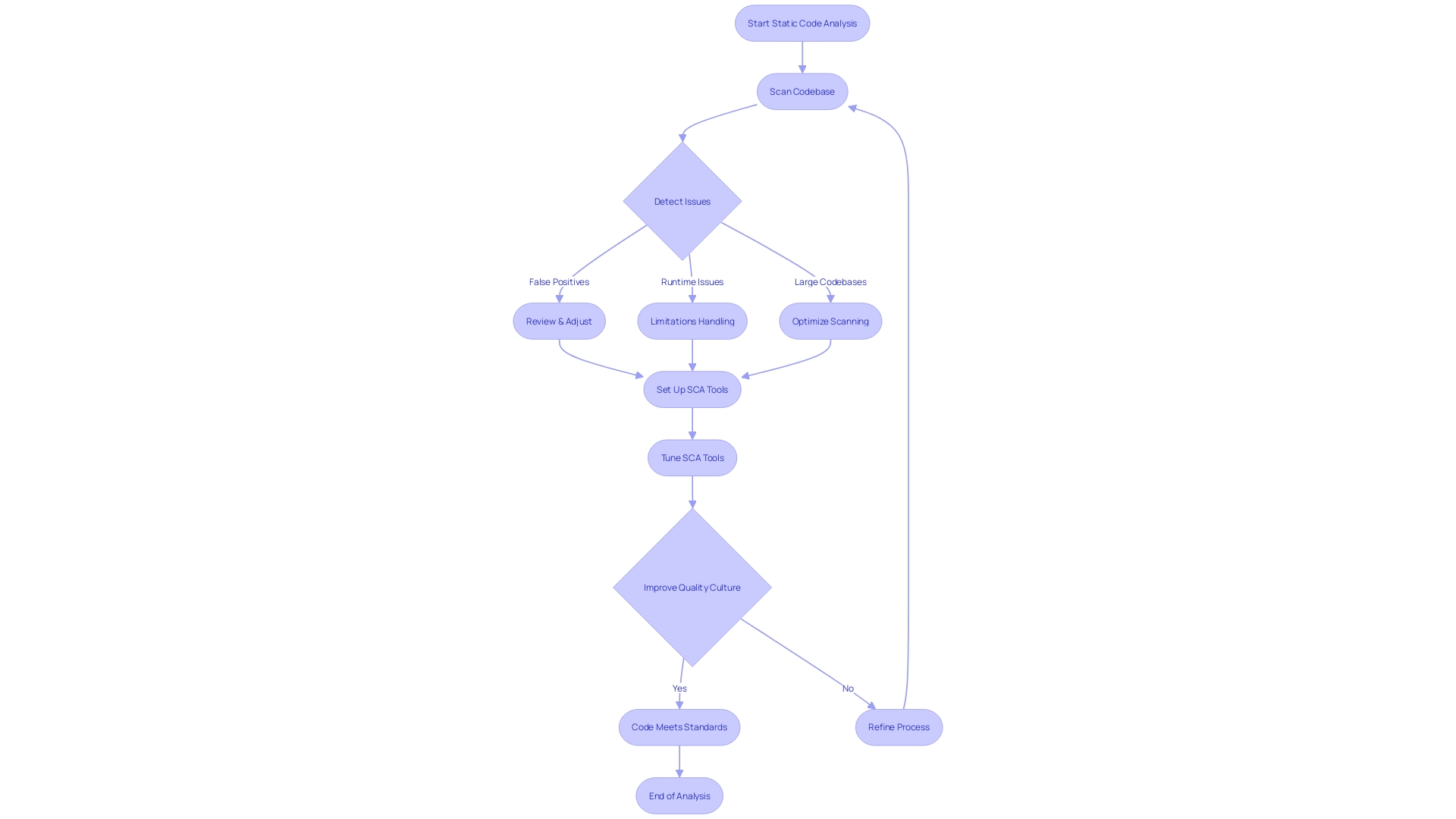
Early Bug Detection and Error Prevention
Static code analysis (SCA) instruments serve as a vital component in software development, providing an in-depth examination of the software at a granular levelâsimilar to a detective scouring for clues. These instruments possess the exceptional ability to analyze through programming without executing it, identifying glitches, and emphasizing possible mistakes that may result in malfunctions or unforeseen actions during execution. By proactively identifying these issues, SCA tools can avert the pitfalls and disruptions caused by logic errors, assertion failures, or typos, as exemplified by the enlightening instances detected in the OpenVINO project's code.
Incorporating static analysis into the development workflow equips teams to enforce a quality culture, vital for crafting resilient and dependable software systems. It enables the establishment of a defense mechanism against common coding vulnerabilities that could otherwise result in flaws in protection or reliability problems. Research underscores the effectiveness of these tools, as evidenced by Google's security engineering team's experience, where a focus on developer ecosystems and safe coding practices led to a substantial reduction in defects across numerous applications and a myriad of developers.
SCA also offers insights into the patterns of mistakes, allowing development teams to analyze trends over time and implement customized solutions to improve both the quality of their programming and the efficiency of their development procedures. Consequently, organizations can greatly decrease the occurrence of flaws and enhance the general dependability of their product offerings. This proactive approach to software quality assurance is not just about making the program work and optimizing it for performance; it's about ensuring the right foundations are laid from the outset, fostering an environment of continuous improvement and excellence in software engineering.
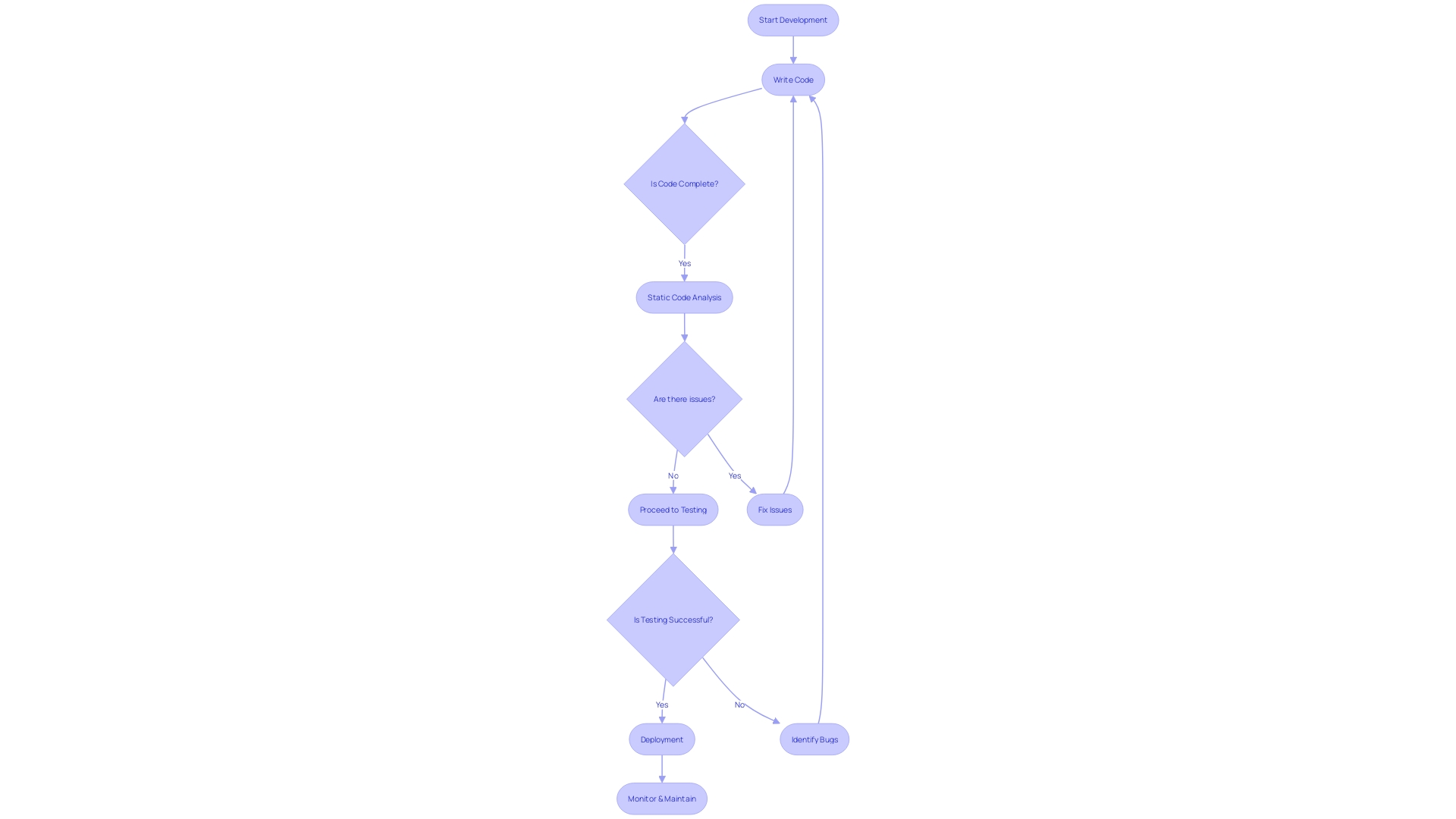
Enhancing Code Quality and Adherence to Standards
Static analysis is a critical method for maintaining high quality, ensuring that developers adhere to coding conventions and best practices. These tools are especially valuable in environments where safety and compliance are of utmost importance, such as the banking industry. For instance, M&T Bank, with its well-established credibility and notable digital evolution, encountered the difficulty of upholding tidy, sustainable programming. Static analyzers can detect a range of issues from unused variables to potential memory leaks, which are crucial for institutions like M&T Bank to avoid costly and damaging security breaches.
Linting, the process of checking for potential errors and inconsistencies in software development, is integral. Linters parse source files to identify patterns that match known issues, such as inconsistent naming conventions or functions that exceed complexity thresholds. Such instruments not only emphasize areas for enhancement but also guarantee that the codebase aligns with industry standards.
In the context of rapidly evolving software development, static application safety solutions must thoroughly examine the intricate web of libraries, frameworks, and custom code that modern applications are built upon. High-quality static analysis tools provide comprehensive coverage, identifying a wide array of vulnerabilities to ensure robust security.
Moreover, as organizations like M&T Bank integrate new technologies to meet customer demands, the pressure to release secure and compliant applications intensifies. Static code analyzers play a crucial role in this process, supporting the maintainability and performance of applications, while minimizing maintenance time and associated costs.
Kai, an experienced product specialist, highlights the significance of selecting the appropriate static analysis solutions to identify flaws and enhance the quality of the application. As systems become more intricate, the function of these instruments in improving the dependability of development processes becomes progressively important.
Ensuring Software Security
Static code analysis (SCA) instruments are essential for upholding software protection. Their capability to identify vulnerabilities early in the development process is crucial. These tools can uncover a variety of vulnerabilities, such as SQL injection, cross-site scripting, and other risky data handling practices. With the insights provided by SCA, developers can proactively resolve issues, thus enhancing the protection level of the software before its release. This proactive measure is crucial in protecting sensitive information and averting incidents.
James Wickett and Ken Johnson, the creators of DryRun Security, acknowledged the importance of equipping developers with efficient protective measures. Wickett, as CEO, observed that developers were concerned with safety and quality but lacked proper tools. On the other hand, Johnson, the CTO with a background in leading security reviews at GitHub, emphasizes the importance of educating developers on security.
DryRun Security showcases an innovative method for SCA with its Contextual Security Analysis, which assesses changes in programming across various dimensions using the SLIDE model (Surface, Language, Intent, Detections, & Environment). This model offers a multifaceted view of the risks associated with software modifications, far beyond a single data point.
Moreover, the latest reports from DryRun Security provide a comprehensive analysis of the supply chain threat landscape. These reports, accessible via different tabs like 'All,' 'Recommended,' and 'Low Risk,' provide a prioritized list of issues to address, complete with in-depth analysis of each issue's impact, scope, and origin.
The adoption of SCA mechanisms aligns with the broader goal of enhancing system quality, which encompasses trustworthiness, dependability, and resilience. As software systems become more intricate, the quality of the programming and the quantity of it both play a crucial role in software security. The use of SCA is not just about detecting flaws but also about contributing to a culture of quality within development teams and organizations as a whole.
Research in the field supports the adoption of SCA instruments, with studies providing guidelines that help developers select the right instruments to detect errors in their code. The study provides valuable understandings into the strengths and weaknesses of different SCA resources and their implications for both practitioners and the future of software engineering.
In summary, the incorporation of SCA into the development workflow is a strategic decision that can greatly enhance the security and dependability of systems. As industry leaders and researchers continue to advocate for enhanced quality practices, SCA solutions stand out as a vital element in the progression of software engineering.
Improving Software Performance
Static analyzers are not just about identifying bugs; they play a pivotal role in enhancing software performance. With their sharp attention to detail, these instruments can identify performance roadblocks such as sluggish algorithms and resources that are being heavily taxed. For instance, the Checkly service experienced a housekeeping process that was dragging its heels. By implementing OpenTelemetry, they were able to address the core backend issues and turn things around.
Moreover, tools like the MSBuild Structured Log Viewer, masterminded by MSBuild guru Kirill Osenkov, make it possible to delve into compilation logs and spot inefficiencies during development. This type of analyzer reporting can be seamlessly integrated into your projects, ensuring that every line of programming is working as hard as it can to keep your software running smoothly.
This meticulous attention to detail in static analysis fosters an environment where performance is continuously scrutinized and enhanced, leading to applications that are not just functional but also fast and efficient. Actually, AI pair-programming tools have shown considerable advantages for developers of every skill level, greatly enhancing efficiency by proposing snippets of programming in live-time.
As the technology environment expands increasingly intricate, the capacity to merge discoveries from diverse examinations becomes essential. Static analysis utilities excel in this area, offering a consolidated perspective on concerns that require attention, thereby streamlining the process of improving both performance and safety. This comprehensive approach ensures a strong and dependable system, resulting in a user experience that is both seamless and secure.
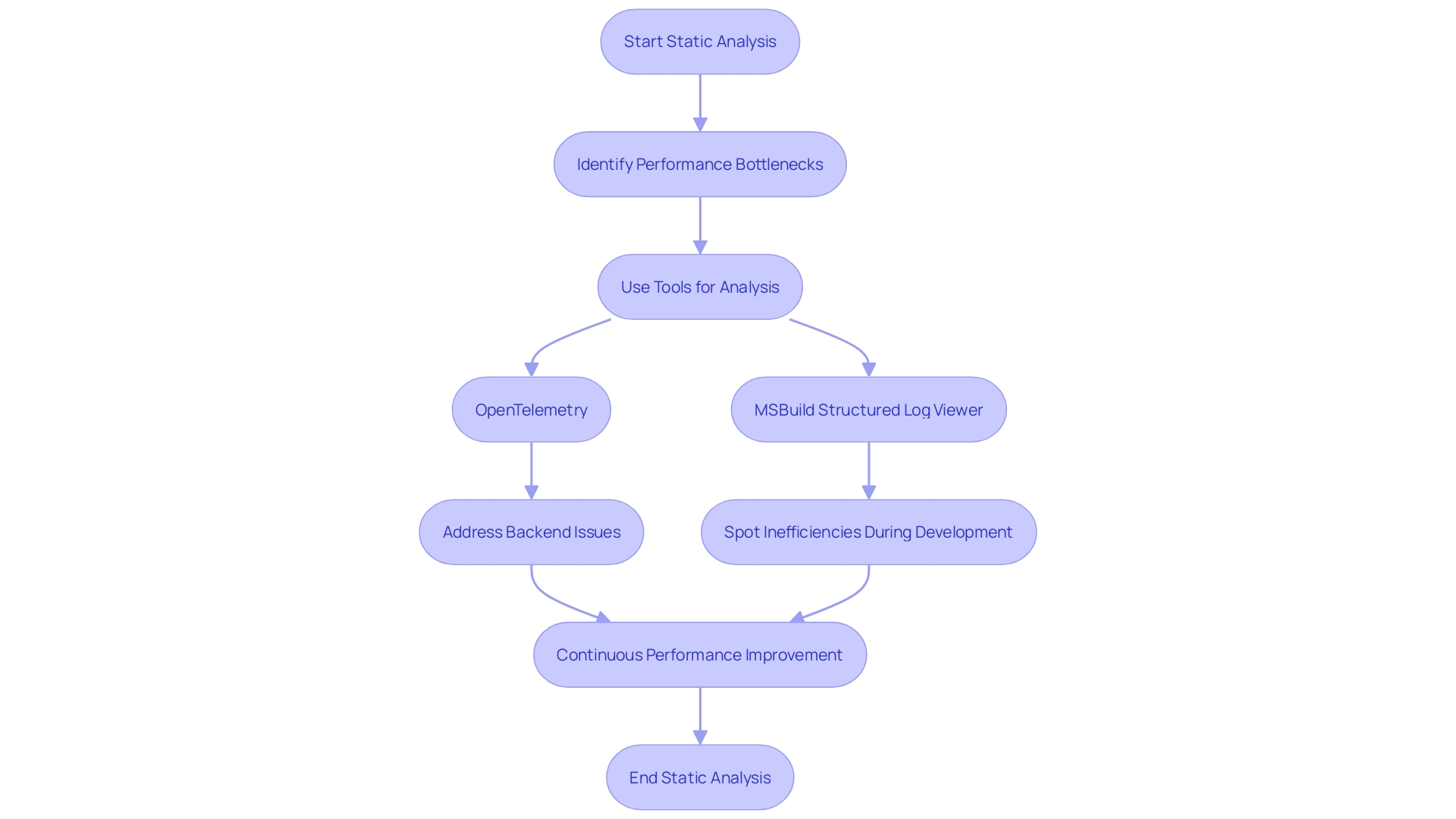
Popular Static Code Analysis Tools
In the realm of software development, the utilization of static analysis techniques has become a cornerstone for enhancing software quality and security. These instruments thoroughly assess source code without running it, identifying possible vulnerabilities and ensuring compliance with coding standards. Among the wide array of choices accessible, certain instruments have gained widespread recognition because of their strong characteristics and effectiveness.
Datadog's static analyzer exemplifies performance optimization, allowing users to conduct analyses within their own CI instances, thereby offering heightened safety and speed. However, resource limitations can pose challenges, as observed with GitHub Actions runners, underscoring the need for efficient resource use in CI environments.
Another remarkable tool is Codiga, which conducts analysis on its servers, enabling developers to initiate scans with ease. This approach alleviates the burden on local resources, providing an alternative for teams facing hardware constraints.
Snyk Code stands out for its rapid and accurate analysis, coupled with a reduced rate of false positives. It offers a suite of features, such as issue filtering, sorting, and grouping, as well as a Priority Score system that amalgamates factors like issue prevalence and risk level into a single score, streamlining the remediation process.
The Forrester Wave™ report for Q3 2023 highlights Synopsys' Coverity® as a leader in the SAST market. Synopsys excels in detection capabilities, product security, and DevSecOps workflows, demonstrating its commitment to seamlessly integrating security into the development lifecycle.
As computer programs become more intricate, the excellence and dependability of the programming are crucial. Static analysis instruments are not only about identifying mistakes; they play a significant role in fostering a culture of excellence within teams and organizations. By incorporating these resources into development workflows, teams can guarantee that their programming is both secure and dependable, promoting a proactive strategy to defect prevention and improving the resilience of their software applications.
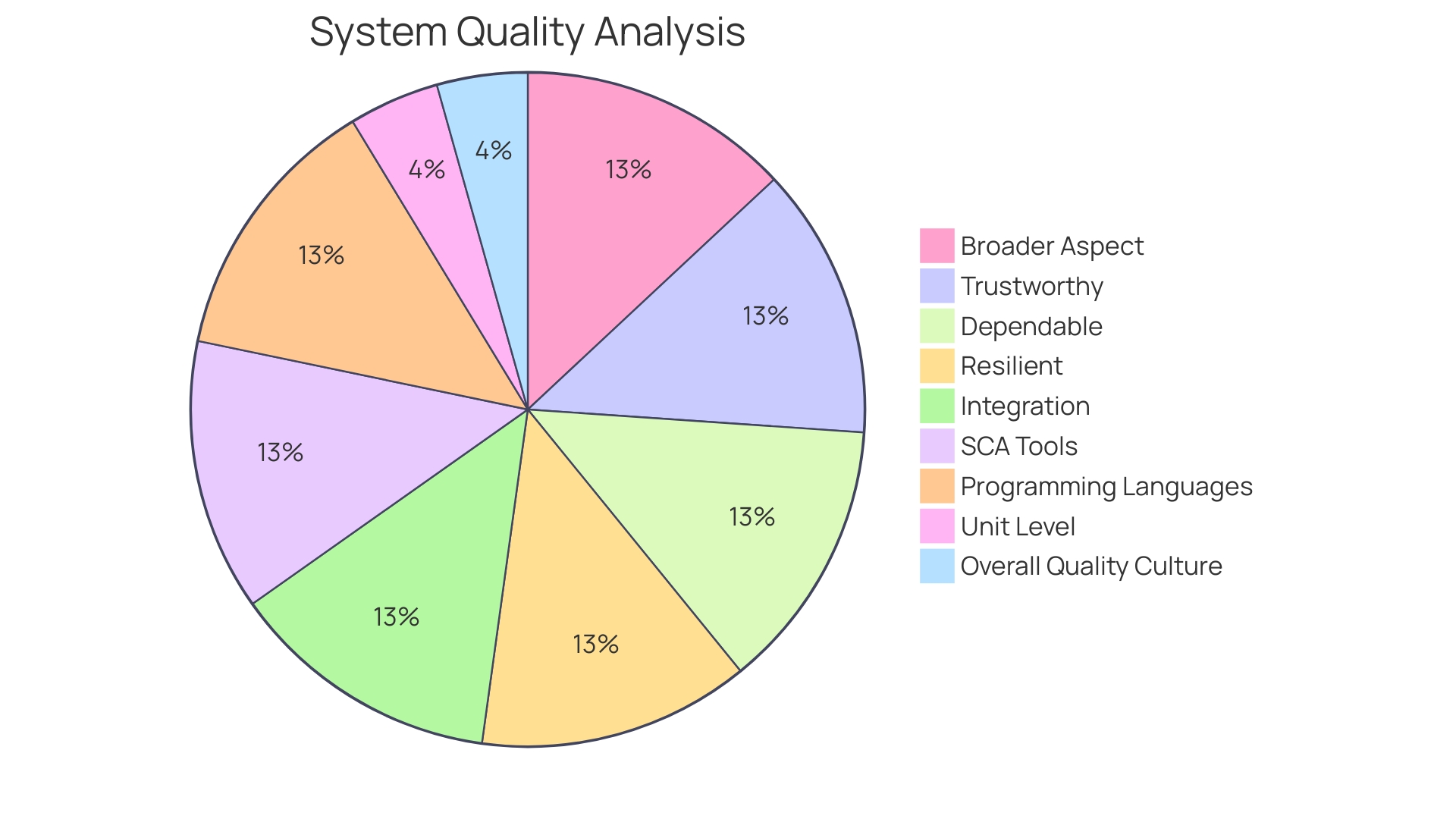
SonarQube: Comprehensive Code Quality and Security Analysis
SonarQube distinguishes itself in the realm of static analysis tools for its ability to scrutinize the quality of software and identify vulnerabilities related to software safety. It caters to a wide range of programming languages, ensuring that development teams can employ it across various projects. Key characteristics of SonarQube encompass the identification of redundant programming constructs, evaluation of code coverage, and detection of potential threats to system safety. These capabilities are crucial in sectors such as banking, where institutions like M&T Bank face the dual challenges of digital transformation and adherence to stringent security and regulatory standards. With over 21,000 employees, M&T Bank has embraced Clean Code practices to enhance software maintainability and performance, reflecting the industry's need for tools that facilitate the creation of clear, maintainable, and efficient software.
Simplicity and readability are fundamental to the philosophy of Clean Code, with the objective of making the programming easily comprehensible and reusable for any developer. SonarQube's analysis aligns with these principles by enforcing quality gatesâcriteria that must meet before being deemed release-ready. This could include maintaining a specific level of coverage or ensuring that no critical vulnerabilities are present.
The banking industry's swift transition to digital services has heightened the embrace of novel technologies, placing utmost importance on the dependability and safety of the systems. Software issues can lead to significant financial and reputational damage, highlighting the importance of static code analysis tools like SonarQube. They provide a safeguard against costly maintenance, breaches, and compliance issues, ensuring that software is not only functional but also secure and aligned with industry regulations.
In the context of the global market, companies like Synopsys have been recognized for their excellence in static application security testing (SAST), with their Coverity® solution achieving high scores for its detection capabilities and integration into DevSecOps workflows. Such accolades reflect the industry's direction towards solutions that seamlessly blend into developer environments and prioritize the delivery of actionable results.
As the banking sector continues to evolve and expand, the importance of high-quality, secure software becomes increasingly critical. SonarQube serves as a valuable asset in this regard, providing a robust framework for achieving and maintaining the high standards required to protect sensitive data and transactions in the digital age.
ESLint: Customizable JavaScript and TypeScript Analysis
Acknowledged as a crucial instrument in software development, ESLint acts as a protector of quality for JavaScript and TypeScript developers. With its primary function being a linter, ESLint meticulously parses source files to identify patterns that could signal potential errors, such as missing semicolons or unused variables, which are common stumbling blocks that even seasoned developers encounter. This process not only flags stylistic inconsistencies but also enforces best practices and coding standards, which are vital for maintaining a clean and efficient codebase.
The customizability of ESLint is one of its standout features, allowing it to adapt to the diverse demands of different projects. It is not only about discovering bugs; it's about advocating a coding philosophy that highlights modularity, clarity, and independenceâkey attributes of testable programming. By emphasizing tight coupling and recommending decoupled structures, ESLint motivates developers to write software that is easier to test and maintain. Additionally, considering the current focus on the swift advancement of AI and its influence on coding practices, resources such as ESLint become increasingly essential in overseeing code quality in a changing technological environment.
The significance of ESLint is underscored by insights from a global developer ecosystem survey, which gathered responses from over 26,000 developers. The survey's findings highlight the widespread usage of JavaScript and TypeScript, emphasizing the need for efficient lighting solutions to assist the large community of developers committed to these programming languages. ESLint, therefore, is not just a tool but a companion for developers, guiding the refinement of their craft and contributing to the robustness of the digital infrastructure that underpins the modern web.
Coverity: Comprehensive Security and Quality Analysis
Coverity distinguishes itself in the static analysis landscape with its strong capabilities in identifying flaws in programming and errors in coding. Through careful analysis of the source material, Coverity reveals significant flaws and vulnerabilities that may result in breaches or problems with quality. It's designed to blend into diverse development environments, offering actionable insights that propel continuous refinement of the codebase.
Security experts often emphasize the importance of scrutinizing privilege boundaries, like those in Linux systems, to detect privilege escalation vulnerabilities. Systems with setuid binaries, improper file permissions, and Unix sockets are typical starting points for such analysis. Coverity's approach aligns with these practices, providing developers with a structured framework to assess and enhance security.
The significance of instruments like Coverity is emphasized by real-world data. The Coverity Scan Report analyzed 250 million lines of open source programming, highlighting the tool's wide coverage and the importance of thorough code inspection. Defect density, a metric that measures flaws per thousand lines of programming, becomes a crucial benchmark for developers utilizing Coverity, guiding them toward more secure and reliable creation of applications.
In the realm of embedded software, where the stakes are highâranging from vehicles to medical devicesâCoverity's early-stage safety checks are pivotal. Ensuring the integrity of these systems is essential, as they perform operations that directly impact human safety. The integration capabilities of this software also excel in Continuous Integration/Continuous Deployment (CI/CD) pipelines, where it can act as a crucial checkpoint before each release, strengthening the code against possible threats.
Coverity's reports, rich with detailed analyses of each identified issue, offer a comprehensive view of the safety and quality landscape of a project. These reports, which can be shared with team members and stakeholders, categorize issues based on severity and actionability, enabling prioritized remediation efforts.
Professionals, similar to those referenced in NISTIR 8397's recommendations for secure application development, acknowledge the importance of such resources in the field. Coverity, through its systematic and scalable threat modeling, assists teams in aligning their efforts with their development methodologies, whether agile or otherwise.
In the end, Coverity is not just a tool for identifying vulnerabilities; it is a crucial component of the software development process that enhances the emphasis on safety and excellence, guaranteeing that the software is not only operational but also strengthened against the constantly changing environment of digital dangers.
Checkmarx: Focused on Security Vulnerabilities
Checkmarx stands out in the field of static code analysis with a strong focus on identifying and addressing vulnerabilities. Utilizing the knowledge of experts like Yehuda, who brings a vast experience from the defense sector and cybersecurity certifications such as CISSP and CCSP, Checkmarx provides a comprehensive solution by scanning codebases for potential threats. Its ability to provide actionable remediation advice is a cornerstone of its integration capabilities with widely-used development tools, supporting a multitude of programming languages.
In the competitive landscape of static application security testing (SAST), Checkmarx stands out through its dedication to fortifying cyberspace safety. This dedication is demonstrated in industry assessments, like The Forrester Wave⢠report, which emphasizes the significance of SAST solutions in seamlessly integrating into developer workflows to quickly identify and rectify flaws in proprietary code.
The Checkmarx platform benefits from insights gained from a variety of data flows and threat models, which are essential in outlining protection and privacy requirements for software products. It focuses on the crucial requirement for safety in a development setting where, even with the obligatory implementation of 2FA, breaches have taken place through compromised PATs, underscoring the importance of watchful protective measures.
Furthermore, current updates from the sector that focuses on safety emphasize the need for prompt fixing to safeguard against weaknesses, with accounts of third-party POCs providing cybercriminals an opening for exploitation. This emphasizes the importance of solutions like Checkmarx that prioritize customer protection and prompt remediation guidance.
Code review remains an integral part of the software development cycle, and Checkmarx's approach aligns with findings from empirical case studies in projects like OpenSSL and PHP. These studies unveil that code evaluations play a significant role in identifying coding weaknesses that could lead to safety concerns, further reinforcing the importance of solutions like Checkmarx in the developer's toolkit for maintaining code reliability and protection.
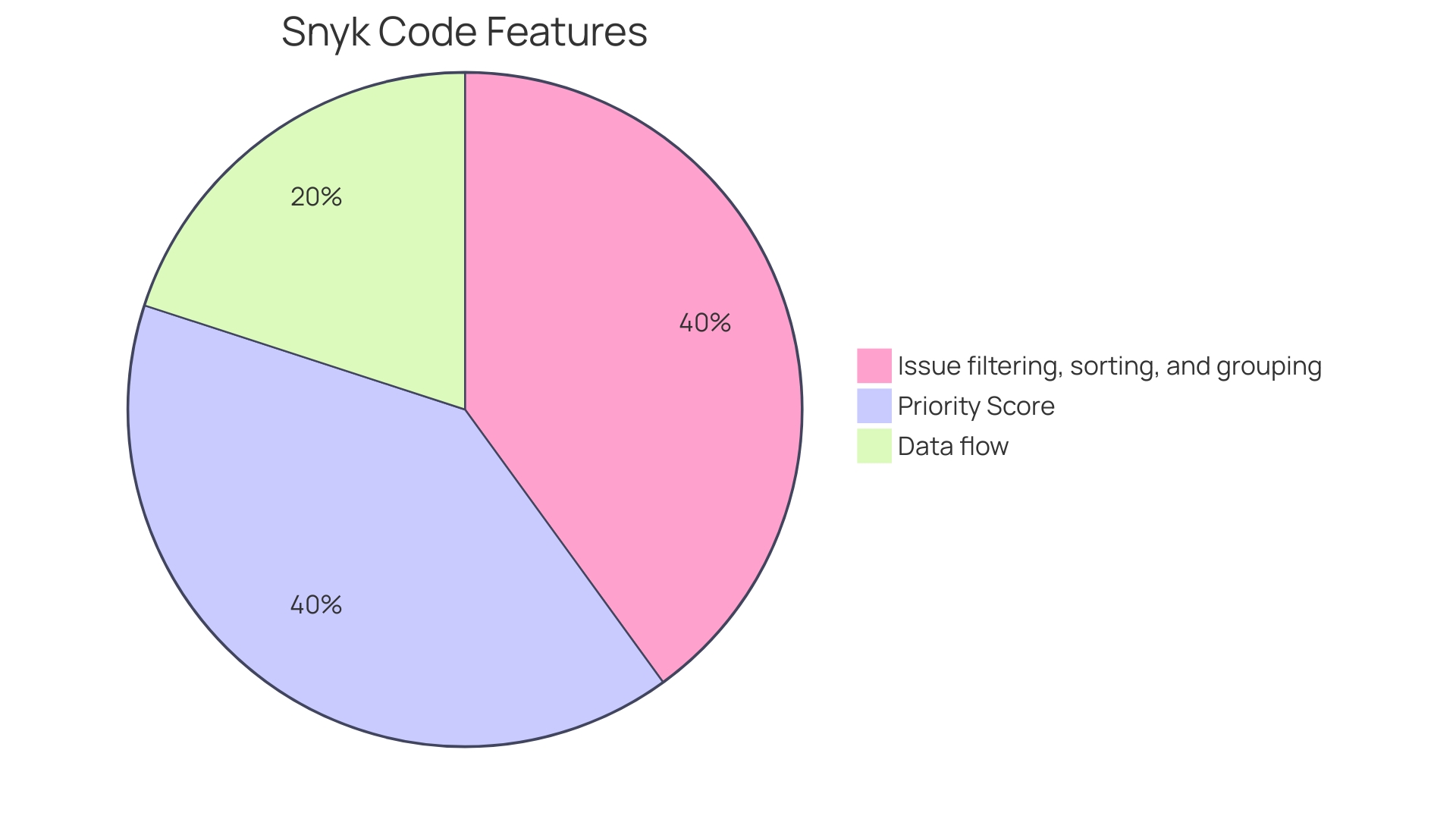
PMD: Identifying Common Coding Flaws
PMD is more than just a static analysis tool; it's an essential ally for developers keen on maintaining high-quality standards. With its powerful rule sets, PMD examines your software for common pitfalls like unused variables, suboptimal programming constructs, and potential bugs that could lead to vulnerabilities. By incorporating PMD into your development process, like the team at M&T Bank did, you can uphold Clean Code standards, ensuring that your application remains efficient, secure, and maintainable in the face of digital transformation challenges. This dedication to the quality of programming is vital in sectors such as banking, where the importance of adhering to regulations and ensuring safety is of utmost importance, and where the consequences of software malfunction can be exceedingly substantial.
Static analysis provides a safety net, detecting errors early in the development cycle, as demonstrated by Google's practice of saving snapshots and build logs. This meticulous approach to development pays dividends, allowing for a swift response to issues and fostering a culture of continuous improvement. PMD supports a variety of programming languages, making it a versatile choice for diverse development teams seeking to minimize maintenance time and costs.
The significance of tools like PMD is emphasized by industry acknowledgement, such as Synopsys' Coverity, which has been praised for its detection capabilities in static application security testing. The capacity to seamlessly merge into developer workflows and prioritize remedies for software vulnerabilities is what distinguishes top SAST solutions. By utilizing PMD, developers can guarantee that their programming not only operates as intended but also complies with coding standards, thereby decreasing intricacy and improving maintainability—as recommended by quality expert Tom McCabe Jr., who promotes simplicity in programming to avoid maintenance headaches.
Ultimately, the adoption of PMD and similar tools is a strategic move for any organization intent on delivering dependable and resilient systems. By addressing quality at the unit level and aligning with industry best practices, teams can create robust applications that stand the test of time.
Implementing Static Code Analysis in Your Workflow
When incorporating static analysis of software (SCA) into your development process, a thorough comprehension of the system's quality is vital. It's important to recognize the aspects and measurements that define the trustworthiness, dependability, and resilience of your software system. These factors influence how well your system behaves and performs in its intended environment. From unit testing, which focuses on individual program units like functions or classes, to automated testing that encompasses various scopes and metrics, each level of system quality analysis plays a pivotal role. M&T Bank, with its rich history and commitment to maintaining high-quality standards, serves as a testament to the importance of establishing clean code practices across an organization.
Static Application Testing (SAST) solutions, like Synopsys' Coverity, are designed to seamlessly integrate into developer workflows, quickly identifying and prioritizing vulnerabilities. The Forrester Wave™ report highlights Synopsys as a leader in the field, recognizing its high scores in detection, product security, and DevSecOps workflows. These instruments play a vital role in fostering a culture of quality within development teams and organizations at large, highlighting the importance of high-impact scan analysis that provides actionable results to developers. By understanding the different types of testing and the value they add, professionals in software development can make informed decisions on the right SCA tools for their projects, ultimately enhancing the quality and reliability of their software.
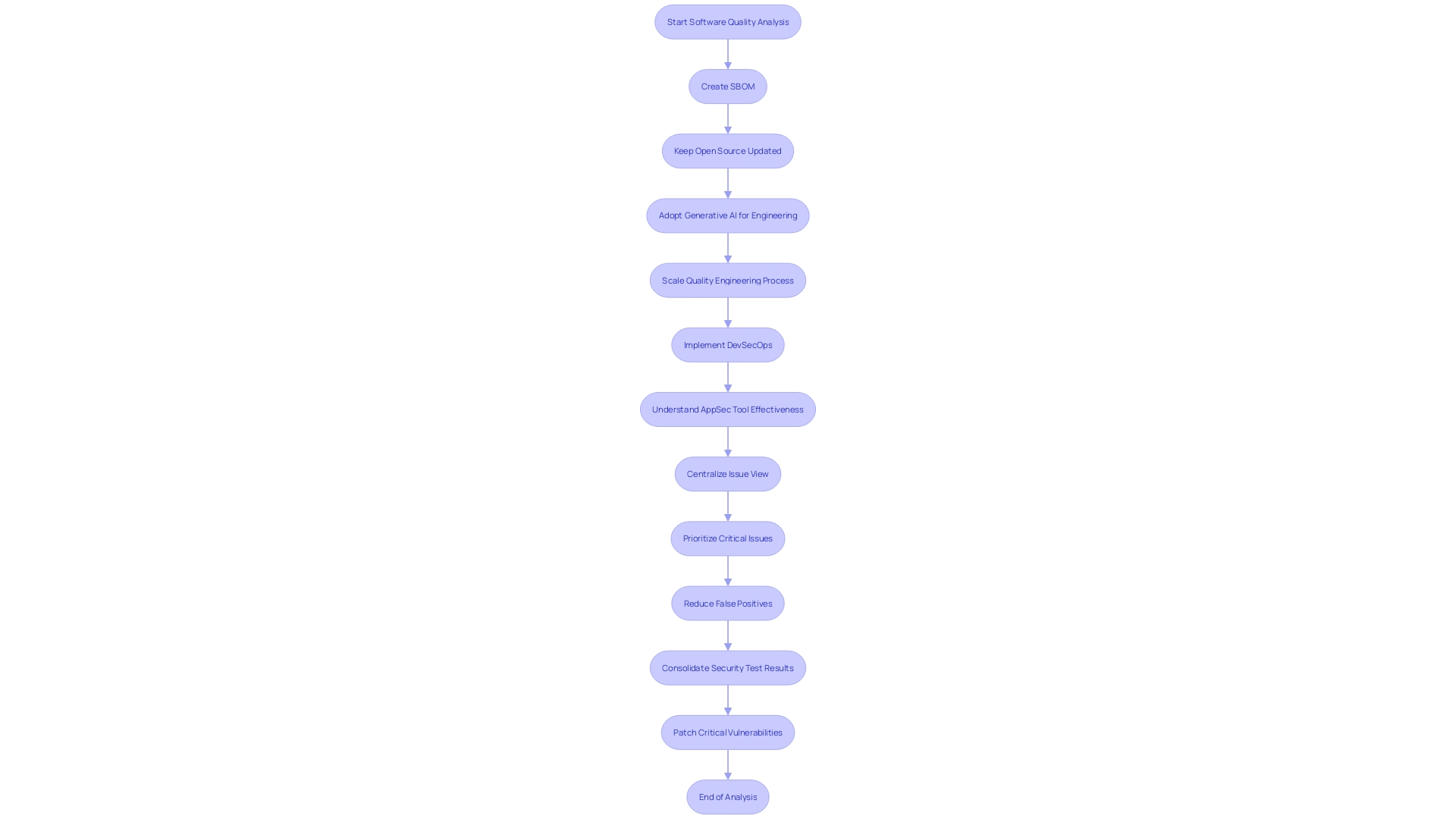
Best Practices for Using Static Code Analyzer Tools
To maximize the effectiveness of static code analysis (SCA) tools, consider these strategies:
- *Automate the analysis by integrating SCA tools within your build process or IDE. This not only saves time but also ensures consistency in program evaluation, much like how M&T Bank implemented Clean Code standards to maintain the integrity of their application amidst a rapidly digitizing industry.
Adjust settings to enforce coding standards and project-specific rules.* Customize your SCA solutions to the distinct requirements of your application, leveraging insights from developers who have witnessed the repercussions of employing extensive amounts of programming with numerous interdependencies.
Consistently assess and resolve problems identified by SCA technology.* Resolving these matters promptly aids in upholding a high standard of quality and security, a practice that mirrors the meticulous approach necessary in today's intricate software environments.
-
Educate your development team on the effective use of SCA tools. Training can improve your team's proficiency, akin to the guidance provided in the article from Google, which emphasized the importance of safe coding practices.
-
Regularly update your analysis rules to keep pace with new requirements and industry standards. As software evolves, so too should your approach to static code analysis, ensuring broad vulnerability coverage and adherence to the latest best practices.
Conclusion
In conclusion, static code analysis (SCA) tools are essential for achieving maximum efficiency and productivity in software development. By integrating SCA tools into the workflow, developers can proactively detect and prevent errors, enhance code quality, and ensure reliable, secure, and high-quality software.
SCA tools play a vital role in industries where failure can result in significant costs, such as banking. They contribute to a culture of quality and excellence within development teams and organizations, reducing maintenance time and costs while improving efficiency, reliability, and security.
These tools also enhance software security by uncovering vulnerabilities and enabling proactive issue resolution. They pinpoint potential security threats like SQL injection and cross-site scripting, bolstering the security posture of the software.
Furthermore, SCA tools contribute to improving software performance by identifying performance roadblocks and inefficiencies. They help create applications that are not only functional but also fast and efficient.
To maximize the effectiveness of SCA tools, it is crucial to choose the right tool that offers comprehensive vulnerability coverage and supports various languages and frameworks. Tools like SonarQube, ESLint, Coverity, and Checkmarx have proven to be robust and effective in enhancing code quality, security, and adherence to coding standards.
In summary, SCA tools are indispensable for achieving maximum efficiency and productivity in software development. They foster a culture of quality, ensuring reliable, secure, and high-quality software. By integrating SCA tools into the workflow, organizations can proactively detect and prevent errors, enhance code quality, and build resilient software systems.
Frequently Asked Questions
What is Static Code Analysis (SCA)?
Static Code Analysis is a method used in software development to examine code for potential errors and vulnerabilities without executing it. It serves as an automated code review process to ensure that programming is dependable, secure, and easy to maintain.
Why is SCA important in industries like banking?
In industries where the cost of failure is high, such as banking, SCA is vital for ensuring protection and compliance. It helps maintain high-quality standards for technological applications, which is essential for performance and compliance in a rapidly digitizing industry.
How do SCA tools improve the quality of a software system?
SCA tools provide insights into potential problems at the initial phase of development, helping to prevent flaws that could result in breaches or unstable applications. They assist in evaluating quality at different levels, such as unit, integration, and system levels.
What benefits did M&T Bank experience from adopting SCA technologies?
By adopting SCA technologies, M&T Bank aimed to implement Clean Code standards, reducing the time and costs required for maintenance while enhancing efficiency, dependability, and safety.
Can SCA tools help in early bug detection and error prevention?
Yes, SCA tools can proactively identify issues such as logic errors, assertion failures, or typos, which helps prevent pitfalls and disruptions caused by these errors.
What role do SCA tools play in enhancing code quality and adherence to standards?
SCA tools help maintain high quality by ensuring developers adhere to coding conventions and best practices, detecting a range of issues from unused variables to potential memory leaks, and ensuring codebase alignment with industry standards.
How do SCA tools ensure software security?
SCA tools can uncover various vulnerabilities early in the development process, such as SQL injection and cross-site scripting, allowing developers to proactively resolve issues and enhance the software's protection level before release.
What is the significance of the Contextual Security Analysis by DryRun Security?
DryRun Security's Contextual Security Analysis assesses programming changes across dimensions using the SLIDE model, providing a multifaceted view of risks associated with software modifications.
How do SCA tools improve software performance?
SCA tools identify performance roadblocks such as sluggish algorithms and heavily taxed resources, enabling developers to address core issues and enhance the efficiency of the software.
What are some popular Static Code Analysis tools?
Some popular SCA tools include Datadog's static analyzer, Codiga, Snyk Code, and Synopsys' Coverity®, which have been recognized for their detection capabilities and effectiveness.
What is SonarQube?
SonarQube is an SCA tool that scrutinizes software quality and identifies vulnerabilities. It supports a wide range of programming languages and helps enforce quality gates and adherence to coding standards.
How does ESLint contribute to maintaining code quality?
ESLint is a linter for JavaScript and TypeScript that identifies potential errors and enforces best practices and coding standards, contributing to clean and efficient codebases.
What does Coverity offer in static analysis?
Coverity provides a structured framework to assess and enhance security, identifying significant flaws and vulnerabilities in the code, and is particularly useful in embedded software systems.
What focus does Checkmarx have in SCA?
Checkmarx focuses on identifying security vulnerabilities and providing actionable remediation advice, supporting a multitude of programming languages and integrating with development tools.
What is PMD, and why is it important?
PMD is an SCA tool that examines software for common coding flaws and supports Clean Code standards, which is essential in sectors where regulations and safety are critical.
How should one implement SCA in their development workflow?
Implementing SCA involves integrating tools within the build process or IDE, customizing settings, consistently resolving identified problems, educating the development team, and regularly updating analysis rules to match new requirements and standards.




